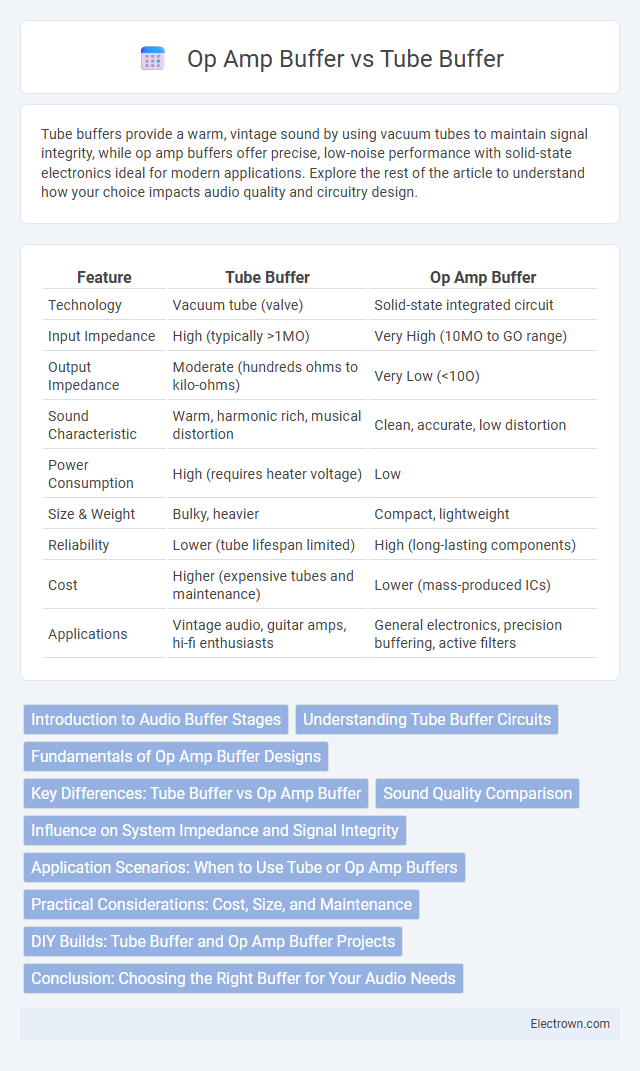Tube buffers provide a warm, vintage sound by using vacuum tubes to maintain signal integrity, while op amp buffers offer precise, low-noise performance with solid-state electronics ideal for modern applications. Explore the rest of the article to understand how your choice impacts audio quality and circuitry design.
Table of Comparison
| Feature | Tube Buffer | Op Amp Buffer |
|---|---|---|
| Technology | Vacuum tube (valve) | Solid-state integrated circuit |
| Input Impedance | High (typically >1MO) | Very High (10MO to GO range) |
| Output Impedance | Moderate (hundreds ohms to kilo-ohms) | Very Low (<10O) |
| Sound Characteristic | Warm, harmonic rich, musical distortion | Clean, accurate, low distortion |
| Power Consumption | High (requires heater voltage) | Low |
| Size & Weight | Bulky, heavier | Compact, lightweight |
| Reliability | Lower (tube lifespan limited) | High (long-lasting components) |
| Cost | Higher (expensive tubes and maintenance) | Lower (mass-produced ICs) |
| Applications | Vintage audio, guitar amps, hi-fi enthusiasts | General electronics, precision buffering, active filters |
Introduction to Audio Buffer Stages
Audio buffer stages serve as critical components in signal processing, ensuring impedance matching and signal integrity between different circuit elements. Tube buffer circuits typically provide warm, harmonically rich sound characteristics favored in vintage and high-end audio gear, while op amp buffers offer low distortion, high input impedance, and precise linear amplification suitable for modern, transparent audio applications. Selecting between tube and op amp buffers depends on the desired tonal quality and technical performance within the audio signal chain.
Understanding Tube Buffer Circuits
Tube buffer circuits utilize vacuum tubes to provide high input impedance and smooth harmonic distortion, enhancing audio signal warmth and richness in analog systems. These buffers excel in preserving signal integrity by offering linear amplification with soft clipping characteristics, making them preferred in vintage audio gear and guitar amplifiers. Compared to op amp buffers, tube buffers introduce subtle coloration and natural compression, which can be desirable for musical applications seeking a more organic sound.
Fundamentals of Op Amp Buffer Designs
Op amp buffer designs rely on high input impedance and low output impedance to provide signal isolation without gain, making them ideal for preserving signal integrity in sensitive circuits. These buffers use feedback mechanisms to maintain unity gain, ensuring output voltage closely follows the input. Understanding the fundamentals of op amp buffers helps you select the right component for applications requiring stable voltage buffering and minimal distortion.
Key Differences: Tube Buffer vs Op Amp Buffer
Tube buffers rely on vacuum tubes to provide a warm, harmonically rich sound with natural compression, favored in audio applications seeking vintage tonal character. Op amp buffers utilize solid-state operational amplifiers, delivering clean, low-noise, and highly linear signal amplification ideal for transparent and accurate audio reproduction. Key differences include the tube buffer's higher distortion and slower response versus the op amp buffer's precise gain control, lower output impedance, and consistent performance across temperature variations.
Sound Quality Comparison
Tube buffers deliver a warm, rich harmonic distortion that many audiophiles associate with a natural and musical sound, enhancing sonic depth and character. Op amp buffers provide a cleaner, more transparent signal with low noise and distortion, preserving the original sound's clarity and precision. Your choice between a tube buffer and an op amp buffer affects the tonal warmth versus sonic accuracy in audio reproduction.
Influence on System Impedance and Signal Integrity
Tube buffers exhibit higher output impedance compared to op amp buffers, which can lead to increased signal degradation and reduced bandwidth in high-impedance systems. Op amp buffers provide low output impedance, maintaining signal integrity by minimizing voltage drop and distortion across varying load conditions. This low impedance characteristic makes op amp buffers more suitable for preserving system impedance matching and ensuring stable frequency response in precision audio or measurement circuits.
Application Scenarios: When to Use Tube or Op Amp Buffers
Tube buffers excel in high-fidelity audio applications where warmth and harmonic richness enhance the sound, such as in guitar amplifiers, studio preamps, and vintage audio equipment. Op amp buffers are preferred in precision electronic circuits requiring low distortion, high input impedance, and stable voltage buffering, commonly found in instrumentation, signal conditioning, and analog-to-digital converter interfaces. Choosing between tube and op amp buffers depends on the desired tonal characteristic and technical performance demands of the application.
Practical Considerations: Cost, Size, and Maintenance
Tube buffers typically incur higher costs due to the expense of vacuum tubes and their limited lifespan, requiring regular replacement and maintenance. They are bulkier and generate more heat, demanding larger enclosures and ventilation compared to op amp buffers, which are compact, cost-effective, and energy-efficient. Op amp buffers offer greater reliability and minimal upkeep, making them more practical for modern audio and electronic applications where size and maintenance are critical factors.
DIY Builds: Tube Buffer and Op Amp Buffer Projects
DIY tube buffer projects harness vacuum tubes to create warm, harmonically rich signal buffering favored in vintage audio circuits, offering unique tonal coloration and natural compression effects. Op amp buffer projects utilize operational amplifiers for precise, clean signal buffering with low distortion and high input impedance, ideal for transparent audio signal routing in guitar pedals and headphone amplifiers. Selecting between tube and op amp buffers in DIY builds depends on desired sonic character, complexity, and component availability.
Conclusion: Choosing the Right Buffer for Your Audio Needs
Tube buffers deliver warm, rich harmonic content ideal for vintage or analog-style audio setups, enhancing musicality at the cost of higher noise and distortion levels. Op amp buffers provide clean, low-noise, and reliable signal buffering with precise impedance matching, making them suitable for modern, transparent sound reproduction in professional routing and recording environments. Selecting the right buffer depends on your desired tonal character and application, balancing the organic coloration of tubes against the accuracy and efficiency of op amps.
tube buffer vs op amp buffer Infographic

 electrown.com
electrown.com